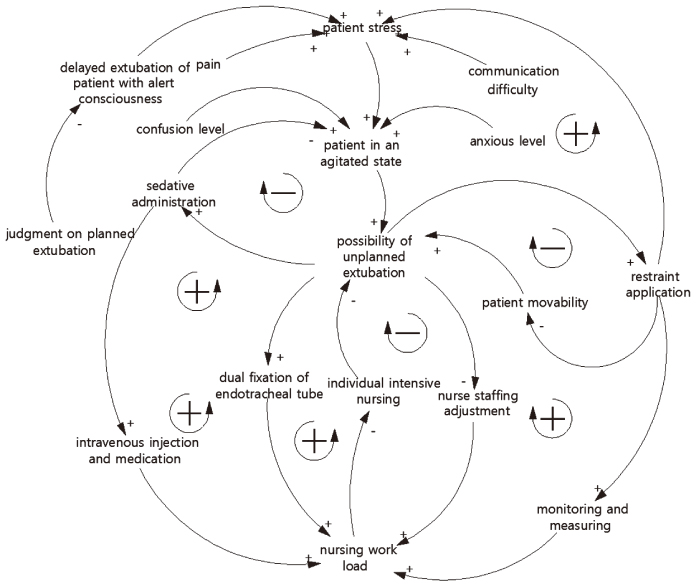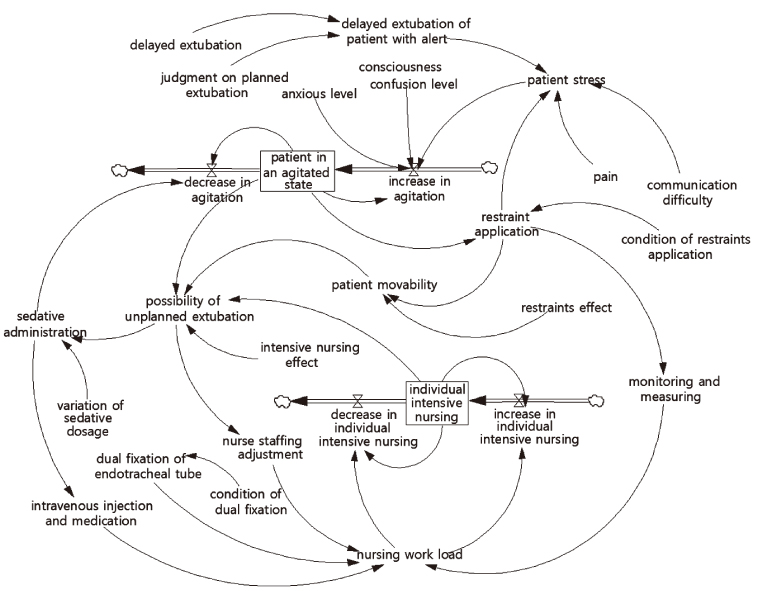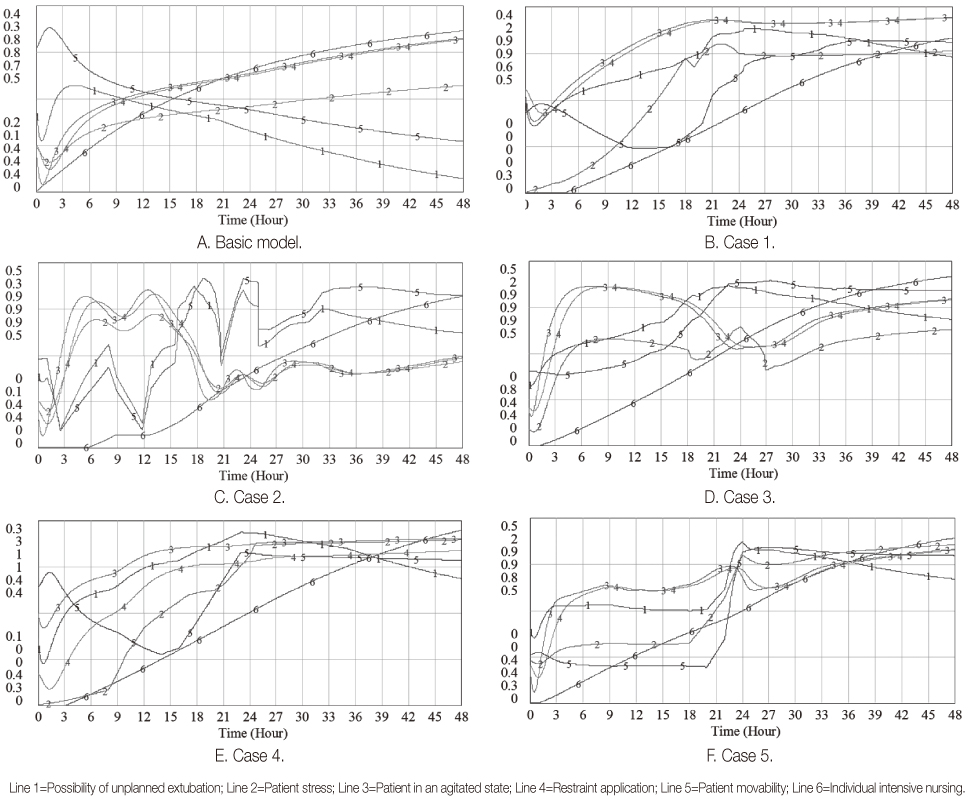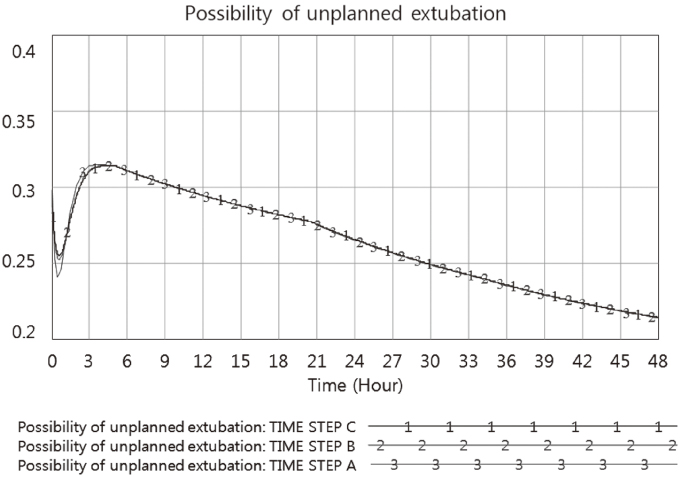J Korean Acad Nurs.
2015 Apr;45(2):280-292. 10.4040/jkan.2015.45.2.280.
Model for Unplanned Self Extubation of ICU Patients Using System Dynamics Approach
- Affiliations
-
- 1College of Nursing Science, Kyung Hee University, Seoul, Korea. ekyun@khu.ac.kr
- 2East-West Nursing Research Institute, Kyung Hee University, Seoul, Korea.
- KMID: 2359866
- DOI: http://doi.org/10.4040/jkan.2015.45.2.280
Abstract
- PURPOSE
In this study a system dynamics methodology was used to identify correlation and nonlinear feedback structure among factors affecting unplanned extubation (UE) of ICU patients and to construct and verify a simulation model.
METHODS
Factors affecting UE were identified through a theoretical background established by reviewing literature and preceding studies and referencing various statistical data. Related variables were decided through verification of content validity by an expert group. A causal loop diagram (CLD) was made based on the variables. Stock & Flow modeling using Vensim PLE Plus Version 6.0b was performed to establish a model for UE.
RESULTS
Based on the literature review and expert verification, 18 variables associated with UE were identified and CLD was prepared. From the prepared CLD, a model was developed by converting to the Stock & Flow Diagram. Results of the simulation showed that patient stress, patient in an agitated state, restraint application, patient movability, and individual intensive nursing were variables giving the greatest effect to UE probability. To verify agreement of the UE model with real situations, simulation with 5 cases was performed. Equation check and sensitivity analysis on TIME STEP were executed to validate model integrity.
CONCLUSION
Results show that identification of a proper model enables prediction of UE probability. This prediction allows for adjustment of related factors, and provides basic data do develop nursing interventions to decrease UE.
MeSH Terms
Figure
Cited by 1 articles
-
Incidence of Unplanned Extubation and Related Factors of Reintubation in the Neonatal Intensive Care Unit
Hee Moon Lim, Hyejung Lee, Mi Jung Park, Jeong Eun Shin
J Korean Soc Matern Child Health. 2022;26(2):72-79. doi: 10.21896/jksmch.2022.26.2.72.
Reference
-
1. Choi YS, Chae YR. Effects of rotated endotracheal tube fixation method on unplanned extubation, oral mucosa and facial skin integrity in ICU patients. J Korean Acad Nurs. 2012; 42(1):116–124. DOI: 10.4040/jkan.2012.42.1.116.2. Yang HJ. Comparison of planned extubation and self-extubation of intubated patients in ICUs [master's thesis]. Busan: Pusan National University;2011.3. Moons P, Sels K, De Becker W, De Geest S, Ferdinande P. Development of a risk assessment tool for deliberate self-extubation in intensive care patients. Intensive Care Med. 2004; 30(7):1348–1355. DOI: 10.1007/s00134-004-2228-2.4. Listello D, Sessler CN. Unplanned extubation. Clinical predictors for reintubation. Chest. 1994; 105(5):1496–1503.5. Moons P, Boriau M, Ferdinande P. Self-extubation risk assessment tool: Predictive validity in a real-life setting. Nurs Crit Care. 2008; 13(6):310–314. DOI: 10.1111/j.1478-5153.2008.00305.x.6. Yeh SH, Lee LN, Ho TH, Chiang MC, Lin LW. Implications of nursing care in the occurrence and consequences of unplanned extubation in adult intensive care units. Int J Nurs Stud. 2004; 41(3):255–262. DOI: 10.1016/s0020-7489(03)00136-6.7. de Lassence A, Alberti C, Azoulay E, Le Miere E, Cheval C, Vincent F, et al. Impact of unplanned extubation and reintubation after weaning on nosocomial pneumonia risk in the intensive care unit: A prospective multicenter study. Anesthesiology. 2002; 97(1):148–156.8. Cho HI, Lee YW, Kim HS, Sim BY. Comparison of related characteristics between unplanned and planned extubation of patients in medical intensive unit. Korean J Adult Nurs. 2012; 24(5):509–519.9. Choi YK, Kim KS. A study on the influencing factor of unplanned endotracheal extubation in ICUs. Qual Improv Health Care. 2002; 9(1):74–89.10. Tanios MA, Epstein SK, Livelo J, Teres D. Can we identify patients at high risk for unplanned extubation? A large-scale multidisciplinary survey. Respir Care. 2010; 55(5):561–568.11. de Groot RI, Dekkers OM, Herold IH, de Jonge E, Arbous MS. Risk factors and outcomes after unplanned extubations on the ICU: A case-control study. Crit Care. 2011; 15(1):R19. DOI: 10.1186/cc9964.12. Koo BN, Koh SO, Kwon TD. Predictors for reintubation after unplanned endotracheal extubation in multidisciplinary intensive care unit. Korean J Crit Care Med. 2003; 18(1):20–25.13. Richmond AL, Jarog DL, Hanson VM. Unplanned extubation in adult critical care. Quality improvement and education payoff. Crit Care Nurse. 2004; 24(1):32–37.14. Kim DH, Moon TH, Kim DH. System dynamics. Seoul: Dae Young Co.;1999.15. Jang KS. A study on establishment of clinical career development model of nurses [dissertation]. Seoul: Yonsei University;2000.16. Lynn MR. Determination and quantification of content validity. Nurs Res. 1986; 35(6):382–385.17. Kim DH. A simulation method of causal maps: NUMBER. Korean Syst Dyn Rev. 2000; 1(2):91–111.18. Kim SW. Systems thinking and scenario planning. Cheongju: CBNU Press;2010.19. Tung A, Tadimeti L, Caruana-Montaldo B, Atkins PM, Mion LC, Palmer RM, et al. The relationship of sedation to deliberate self-extubation. J Clin Anesth. 2001; 13(1):24–29.20. Chang LC, Liu PF, Huang YL, Yang SS, Chang WY. Risk factors associated with unplanned endotracheal self-extubation of hospitalized intubated patients: A 3-year retrospective case-control study. Appl Nurs Res. 2011; 24(3):188–192. DOI: 10.1016/j.apnr.2009.09.002.21. Curry K, Cobb S, Kutash M, Diggs C. Characteristics associated with unplanned extubations in a surgical intensive care unit. Am J Crit Care. 2008; 17(1):45–51.22. Razek T, Gracias V, Sullivan D, Braxton C, Gandhi R, Gupta R, et al. Assessing the need for reintubation: A prospective evaluation of unplanned endotracheal extubation. J Trauma. 2000; 48(3):466–469.23. Choi EH, Kim JH, Park MH, Lee JY. The comparison of the unplanned extubation according to the method for fixing the endotracheal tube. Clin Nurs Res. 2006; 12(2):7–16.24. Birkett KM, Southerland KA, Leslie GD. Reporting unplanned extubation. Intensive Crit Care Nurs. 2005; 21(2):65–75. DOI: 10.1016/j.iccn.2004.07.012.25. Kim HJ. A study on the influencing factor of unplanned extubation in MICU [master's thesis]. Seoul: Chung-Ang University;2005.26. Hofsø K, Coyer FM. Part 1. Chemical and physical restraints in the management of mechanically ventilated patients in the ICU: Contributing factors. Intensive Crit Care Nurs. 2007; 23(5):249–255. DOI: 10.1016/j.iccn.2007.04.003.27. Chang LY, Wang KW, Chao YF. Influence of physical restraint on unplanned extubation of adult intensive care patients: A case-control study. Am J Crit Care. 2008; 17(5):408–415.28. Balon JA. Common factors of spontaneous self-extubation in a critical care setting. Int J Trauma Nurs. 2001; 7(3):93–99. DOI: 10.1067/mtn.2001.117769.29. Atkins PM, Mion LC, Mendelson W, Palmer RM, Slomka J, Franko T. Characteristics and outcomes of patients who self-extubate from ventilatory support: A case-control study. Chest. 1997; 112(5):1317–1323.30. Kim JS, Lee ES, Park JH. Effects on unplanned extubation, oral mucosa, and facial skin integrity of new method to secure endotracheal tube. J Korean Clin Nurs Res. 2009; 15(3):49–59.
- Full Text Links
- Actions
-
Cited
- CITED
-
- Close
- Share
- Similar articles
-
- Case-control Study on Risk Factors of Unplanned Extubation Based on Patient Safety Model in Critically Ill Patients with Mechanical Ventilation
- Predictors for Reintubation after Unplanned Endotracheal Extubation in Multidisciplinary Intensive Care Unit
- Incidence of Unplanned Extubation and Related Factors of Reintubation in the Neonatal Intensive Care Unit
- Comparison of Related Characteristics between Unplanned and Planned Extubation of Patients in Medical Intensive Unit
- Effects of Rotated Endotracheal Tube Fixation Method on Unplanned Extubation, Oral Mucosa and Facial Skin Integrity in ICU Patients





